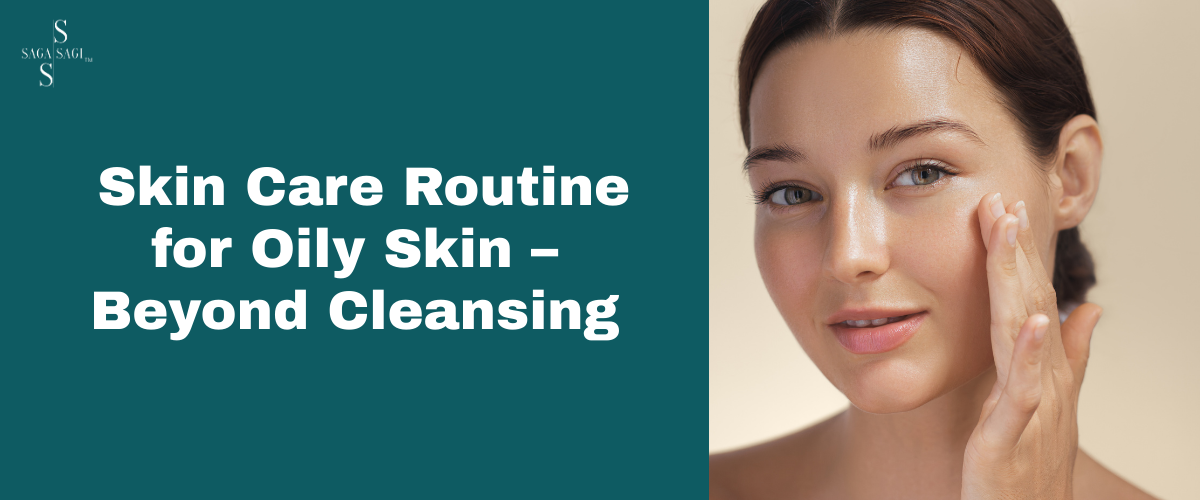Dealing with oily skin can often feel like a never-ending battle against shine, enlarged pores, and those unwelcome blemishes. Many people believe that simply washing their face more frequently is the ultimate solution. However, achieving a balanced and healthy complexion when you have oily skin requires a more thoughtful and comprehensive approach – a dedicated skin care routine for oily skin that goes far beyond just cleansing. This guide will walk you through the essential steps, inspired by expert advice, to help you effectively manage oiliness and reveal clearer, healthier skin.
key takeaways
- Understand Oily Skin: Oily skin is due to the overproduction of sebum. Factors like genetics, hormones, and diet can contribute. Avoid over washing as it can worsen oiliness.
- Gentle Cleansing is Crucial: Cleanse morning and night with a mild, water-based or soap less cleanser to remove dirt, oil, and impurities without stripping the skin.
- Exfoliate Regularly: Exfoliation removes dead skin cells that can clog pores. Use physical or chemical exfoliants (like salicylic acid) 1-3 times a week, being careful not to over-exfoliate.
- Use Toner: An alcohol-free toner can help balance the skin’s pH and prepare it for other products. Look for beneficial ingredients like witch hazel or niacinamide.
- Apply Targeted Serums: Serums with active ingredients like niacinamide and salicylic acid can address specific concerns like oil production, redness, and breakouts.
- Moisturize Lightly: Even oily skin needs hydration. Use a lightweight, non-comedogenic moisturizer (gel-based or light lotion) to maintain the skin barrier and prevent compensatory oil production.
- Protect with Sunscreen Daily: Use an oil-free or non-comedogenic broad-spectrum SPF 30+ sunscreen every morning to protect against sun damage.
- Consistency is Key: Follow your routine morning and night for best results.
- Avoid Harsh Products: Do not use overly drying products that can disrupt the skin’s balance and increase oil production.
- Listen to Your Skin: Adjust your routine as needed based on how your skin responds to products and environmental changes.
- Saga Sagi Products: The blog post mentioned Saga Sagi’s 10% Niacinamide Face Serum with 1% Zinc Acid as a beneficial serum for oily skin and their Natural Sunscreen Lotion SPF 50 PA++ as a good option for sun protection.
Understanding Oily Skin: The Foundation of Your Routine
Before diving into the specifics of a face care routine for oily skin, it’s crucial to understand what makes oily skin, well, oily. Oily skin is characterized by the overproduction of sebum, a natural oil produced by the sebaceous glands. While sebum is essential for keeping the skin moisturized and protected, an excess can lead to that characteristic shine, particularly in the T-zone (forehead, nose, and chin). Enlarged pores become more visible as they work to release this extra oil, and unfortunately, this oily environment can also be a breeding ground for bacteria, contributing to the formation of blackheads, whiteheads, and acne.
Several factors can contribute to oily skin. Genetics play a significant role, meaning you might be predisposed to producing more sebum. Hormonal fluctuations, particularly during adolescence, menstruation, or times of stress, can also trigger increased oil production. Interestingly, even your diet might have an impact. Consuming a high glycemic-index diet and dairy products (except for cheese) has been linked to increased IGF-1 generation, which in turn can boost sebum production.
One common misconception is that over-washing oily skin will solve the problem. While it might temporarily remove surface oil, excessive washing can actually strip your skin of its natural moisture barrier. This can paradoxically signal to your skin that it needs to produce even more oil to compensate, leading to a vicious cycle. Therefore, an effective best skin care routine for oily skin focuses on balance, not aggressive stripping.
The Core Steps of an Effective Skin Care Routine for Oily Skin
A well-structured skin care routine for oily skin involves several key steps, each playing a vital role in managing oiliness and promoting skin health. Let’s break down each step:
Gentle Cleansing: The Crucial First Step (Morning and Night)
Cleansing is the cornerstone of any skin care routine for oily skin, both in your morning skin care routine for oily skin and your night skin care routine for oily skin. The goal here is to remove dirt, excess oil, makeup, and impurities that accumulate throughout the day and night. However, as mentioned earlier, gentleness is key. Opt for a mild, water-based or soapless cleanser. Look for formulations that won’t leave your skin feeling tight or dry after washing. In the morning, cleansing helps to remove any sebum that has accumulated overnight, preparing your skin for the day’s products. At night, it’s essential to thoroughly cleanse to remove all traces of makeup, pollutants, and the day’s oil buildup, allowing your skin to breathe and repair itself.
Exfoliation: Sloughing Away Impurities for Clearer Skin
Exfoliation is an important step in a skin care routine for oily skin as it helps to remove dead skin cells from the surface of the skin. These dead cells can mix with excess sebum and clog pores, leading to breakouts – a common concern for oily skin types. Regular exfoliation can help to prevent this buildup, revealing brighter and smoother skin. There are two main types of exfoliants:
- Physical Exfoliants: These include scrubs with small particles (like sugar or microbeads) or tools like cleansing brushes. While they can provide immediate results, be cautious, especially if you have inflammatory acne, as harsh scrubbing can irritate the skin and potentially worsen breakouts.
- Chemical Exfoliants: These use acids like Alpha Hydroxy Acids (AHAs) such as glycolic and lactic acid, and Beta Hydroxy Acids (BHAs) like salicylic acid. Salicylic acid is particularly beneficial for oily and acne-prone skin as it can penetrate into the pores to dissolve oil and debris.
Start by exfoliating once or twice a week and gradually increase the frequency as your skin tolerates it. Over-exfoliation can lead to irritation, redness, and sensitivity, so pay close attention to how your skin responds.
Toning: Balancing and Preparing Your Skin
Toning is a step that can be particularly beneficial for oily skin. Toners are designed to help balance the skin’s pH after cleansing and prepare it for the absorption of subsequent products like serums and moisturizers. Look for alcohol-free toners, as alcohol can be drying and irritating. Some toners contain ingredients like witch hazel or niacinamide, which can offer additional benefits such as controlling oil production, reducing the appearance of pores, and providing a soothing effect. Incorporate a toner into both your morning skin care routine for oily skin and night skin care routine for oily skin after cleansing.
Targeted Treatment (Serums): Addressing Specific Oily Skin Concerns
Serums are concentrated formulas containing active ingredients that target specific skin concerns. For oily skin, serums can be incredibly beneficial. Look for serums containing ingredients like:
- Niacinamide: This form of vitamin B3 is known for its ability to reduce redness, minimize the appearance of pores, regulate oil production, and improve the skin barrier function.
- Salicylic Acid: As mentioned earlier, this BHA is excellent for unclogging pores and treating breakouts.
- Vitamin C: While known for its brightening and antioxidant properties, some lighter formulations of Vitamin C serums can also be suitable for oily skin.
Consider incorporating a serum into your morning skin care routine for oily skin and/or your night skin care routine for oily skin after toning. Saga Sagi offers a 10% Niacinamide Face Serum with 1% Zinc Acid. Niacinamide is a powerhouse ingredient for oily skin, helping to reduce redness and regulate oil production. Zinc can also be beneficial for its anti-inflammatory and oil-controlling properties.
Lightweight Moisturizing: Hydration is Key, Even for Oily Skin
It might seem counterintuitive to moisturize oily skin, but it’s a crucial step in maintaining a healthy skin barrier. When your skin is dehydrated, it can actually produce more oil to compensate for the lack of moisture. The key is to choose a lightweight, non-comedogenic moisturizer that won’t clog your pores. Look for gel-based or light lotion formulas that absorb quickly and don’t leave a greasy residue. Hyaluronic acid is a great hydrating ingredient that is lightweight and suitable for oily skin. Moisturizing should be a part of both your morning skin care routine for oily skin and your night skin care routine for oily skin to keep your skin balanced and protected.
Sun Protection: A Non-Negotiable Step for All Skin Types
Regardless of your skin type, daily sunscreen is non-negotiable. Sun exposure can cause significant damage to the skin, leading to premature aging, hyperpigmentation, and an increased risk of skin cancer. For oily skin, it’s essential to choose an oil-free or non-comedogenic sunscreen with a broad-spectrum SPF of 30 or higher. Gel or fluid formulations are often preferred as they tend to be lighter and less likely to clog pores. Apply sunscreen as the final step in your morning skin care routine for oily skin, even on cloudy days. Saga Sagi offers a Natural Sunscreen Lotion SPF 50 PA++. Choosing a higher SPF and a product specifically formulated to be lightweight can be beneficial for oily skin.
Important Considerations for Maintaining Your Oily Skin Routine
Consistency is key when it comes to seeing results from your skin care routine for oily skin. Stick with your routine both morning and night, even when you’re tired. Avoid using harsh or overly drying products that can strip your skin and disrupt its natural balance, potentially leading to increased oil production. Listen to your skin and be prepared to adjust your routine as needed based on how your skin responds to different products and environmental factors. You might find that you need to exfoliate more or less frequently depending on the season or the condition of your skin.
Conclusion
Managing oily skin effectively requires a consistent and well-thought-out skin care routine for oily skin that extends beyond simply washing your face. By incorporating gentle cleansing, regular exfoliation, balancing toners, targeted serums, lightweight moisturizers, and daily sun protection into both your morning skin care routine for oily skin and your night skin care routine for oily skin, you can work towards achieving a healthier, more balanced, and less shiny complexion. Remember that finding the best skin care routine for oily skin is a personal journey, and it might take some experimentation to discover the products and routine that work best for you. Embrace the process, be patient, and celebrate the improvements you see as you consistently care for your oily skin.

